Intracranial Pressure: Pathophysiology, Guidelines & Family Role
VerifiedAdded on 2023/06/11
|11
|3037
|51
Case Study
AI Summary
This case study examines Elevated Intracranial Pressure (ICP) through the experiences of two patients, Leo and Tamara, focusing on the pathophysiology of ICP symptoms such as severe headaches, vomiting, and visual difficulties, linking them to conditions like subarachnoid hemorrhage and traumatic brain injury. It delves into the ASAH and MTBI guidelines for managing ICP, emphasizing diagnostic procedures and treatment options. Furthermore, the study underscores the critical role of family members in recognizing patient deterioration, participating in treatment decisions, and providing essential support during the recovery process, highlighting the importance of family involvement in healthcare. Desklib provides solved assignments.
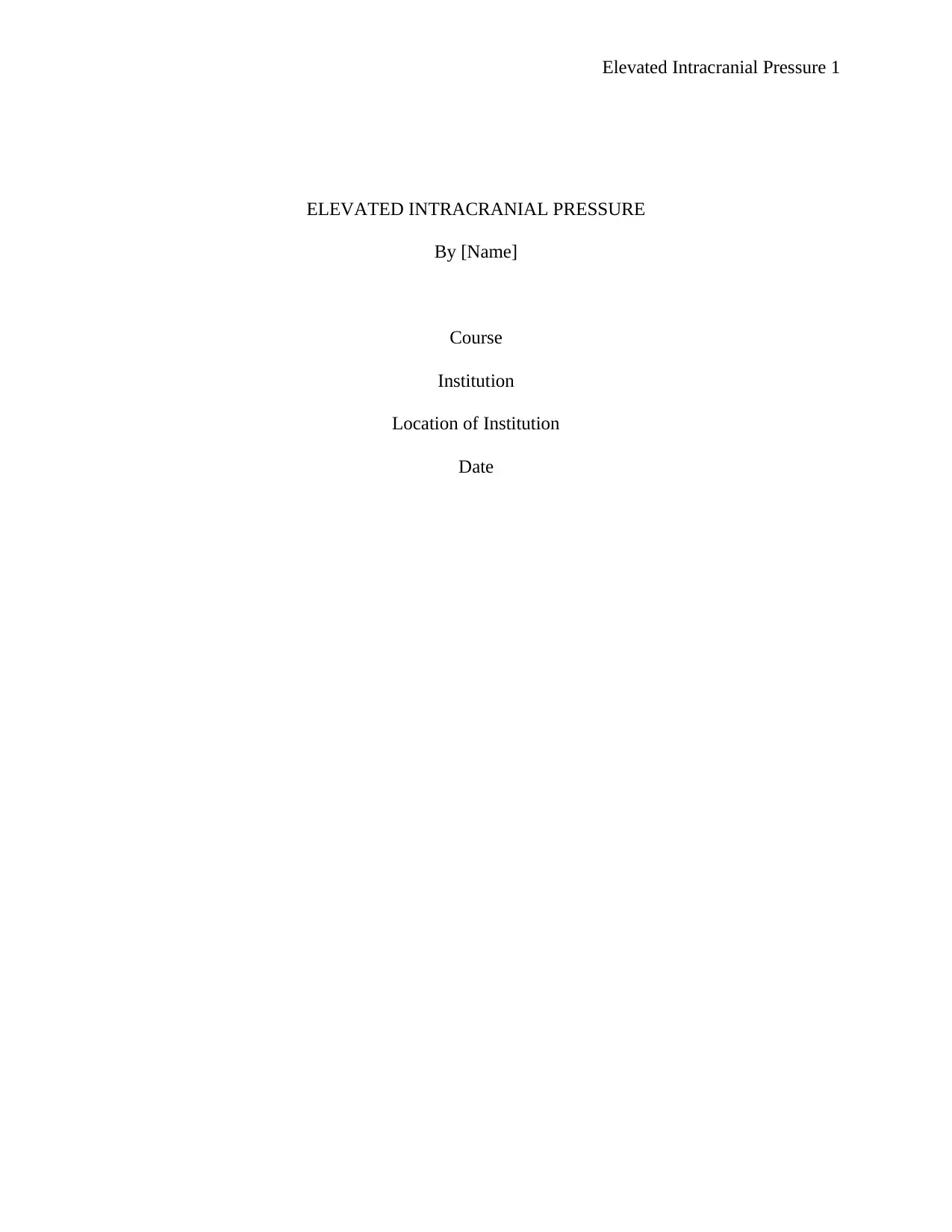
Elevated Intracranial Pressure 1
ELEVATED INTRACRANIAL PRESSURE
By [Name]
Course
Institution
Location of Institution
Date
ELEVATED INTRACRANIAL PRESSURE
By [Name]
Course
Institution
Location of Institution
Date
Secure Best Marks with AI Grader
Need help grading? Try our AI Grader for instant feedback on your assignments.
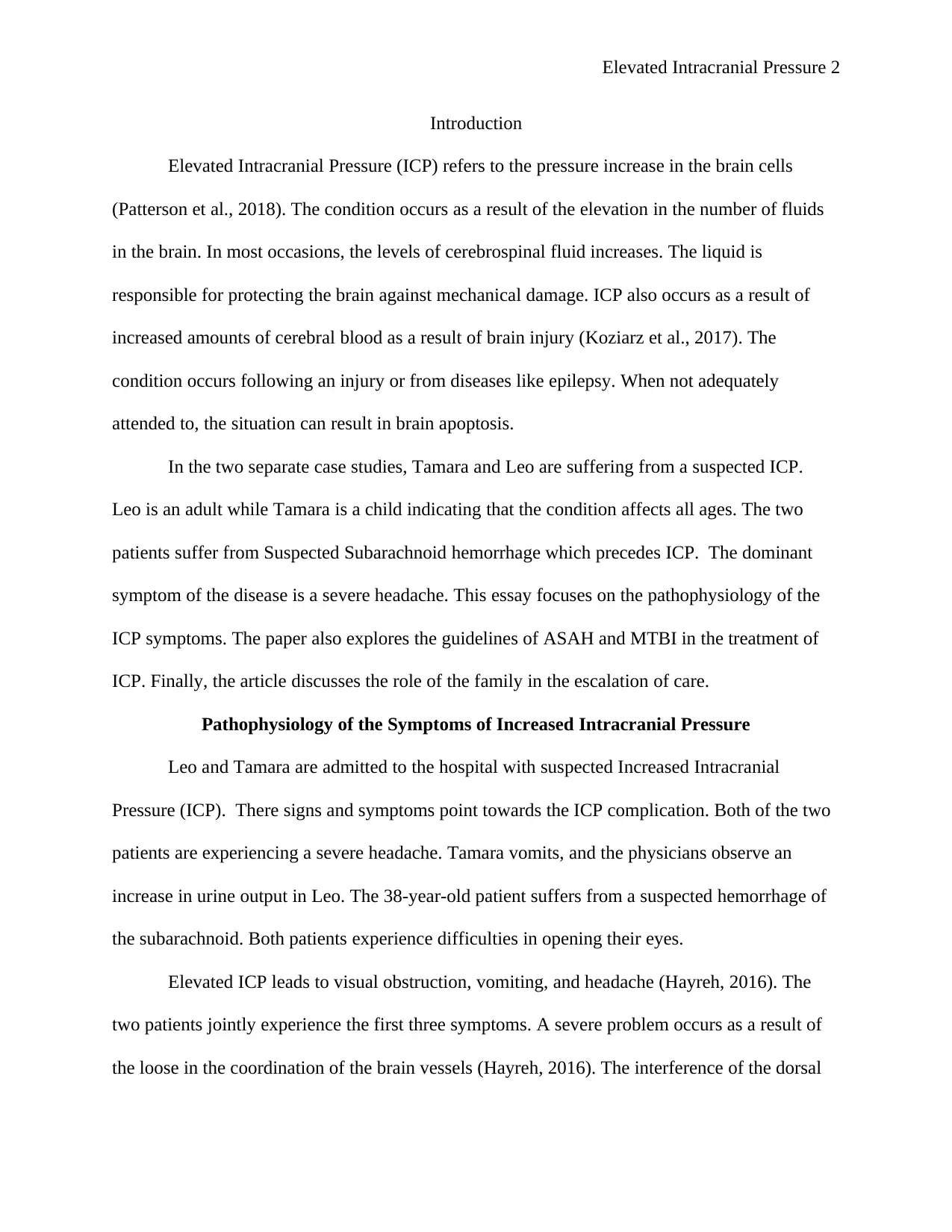
Elevated Intracranial Pressure 2
Introduction
Elevated Intracranial Pressure (ICP) refers to the pressure increase in the brain cells
(Patterson et al., 2018). The condition occurs as a result of the elevation in the number of fluids
in the brain. In most occasions, the levels of cerebrospinal fluid increases. The liquid is
responsible for protecting the brain against mechanical damage. ICP also occurs as a result of
increased amounts of cerebral blood as a result of brain injury (Koziarz et al., 2017). The
condition occurs following an injury or from diseases like epilepsy. When not adequately
attended to, the situation can result in brain apoptosis.
In the two separate case studies, Tamara and Leo are suffering from a suspected ICP.
Leo is an adult while Tamara is a child indicating that the condition affects all ages. The two
patients suffer from Suspected Subarachnoid hemorrhage which precedes ICP. The dominant
symptom of the disease is a severe headache. This essay focuses on the pathophysiology of the
ICP symptoms. The paper also explores the guidelines of ASAH and MTBI in the treatment of
ICP. Finally, the article discusses the role of the family in the escalation of care.
Pathophysiology of the Symptoms of Increased Intracranial Pressure
Leo and Tamara are admitted to the hospital with suspected Increased Intracranial
Pressure (ICP). There signs and symptoms point towards the ICP complication. Both of the two
patients are experiencing a severe headache. Tamara vomits, and the physicians observe an
increase in urine output in Leo. The 38-year-old patient suffers from a suspected hemorrhage of
the subarachnoid. Both patients experience difficulties in opening their eyes.
Elevated ICP leads to visual obstruction, vomiting, and headache (Hayreh, 2016). The
two patients jointly experience the first three symptoms. A severe problem occurs as a result of
the loose in the coordination of the brain vessels (Hayreh, 2016). The interference of the dorsal
Introduction
Elevated Intracranial Pressure (ICP) refers to the pressure increase in the brain cells
(Patterson et al., 2018). The condition occurs as a result of the elevation in the number of fluids
in the brain. In most occasions, the levels of cerebrospinal fluid increases. The liquid is
responsible for protecting the brain against mechanical damage. ICP also occurs as a result of
increased amounts of cerebral blood as a result of brain injury (Koziarz et al., 2017). The
condition occurs following an injury or from diseases like epilepsy. When not adequately
attended to, the situation can result in brain apoptosis.
In the two separate case studies, Tamara and Leo are suffering from a suspected ICP.
Leo is an adult while Tamara is a child indicating that the condition affects all ages. The two
patients suffer from Suspected Subarachnoid hemorrhage which precedes ICP. The dominant
symptom of the disease is a severe headache. This essay focuses on the pathophysiology of the
ICP symptoms. The paper also explores the guidelines of ASAH and MTBI in the treatment of
ICP. Finally, the article discusses the role of the family in the escalation of care.
Pathophysiology of the Symptoms of Increased Intracranial Pressure
Leo and Tamara are admitted to the hospital with suspected Increased Intracranial
Pressure (ICP). There signs and symptoms point towards the ICP complication. Both of the two
patients are experiencing a severe headache. Tamara vomits, and the physicians observe an
increase in urine output in Leo. The 38-year-old patient suffers from a suspected hemorrhage of
the subarachnoid. Both patients experience difficulties in opening their eyes.
Elevated ICP leads to visual obstruction, vomiting, and headache (Hayreh, 2016). The
two patients jointly experience the first three symptoms. A severe problem occurs as a result of
the loose in the coordination of the brain vessels (Hayreh, 2016). The interference of the dorsal
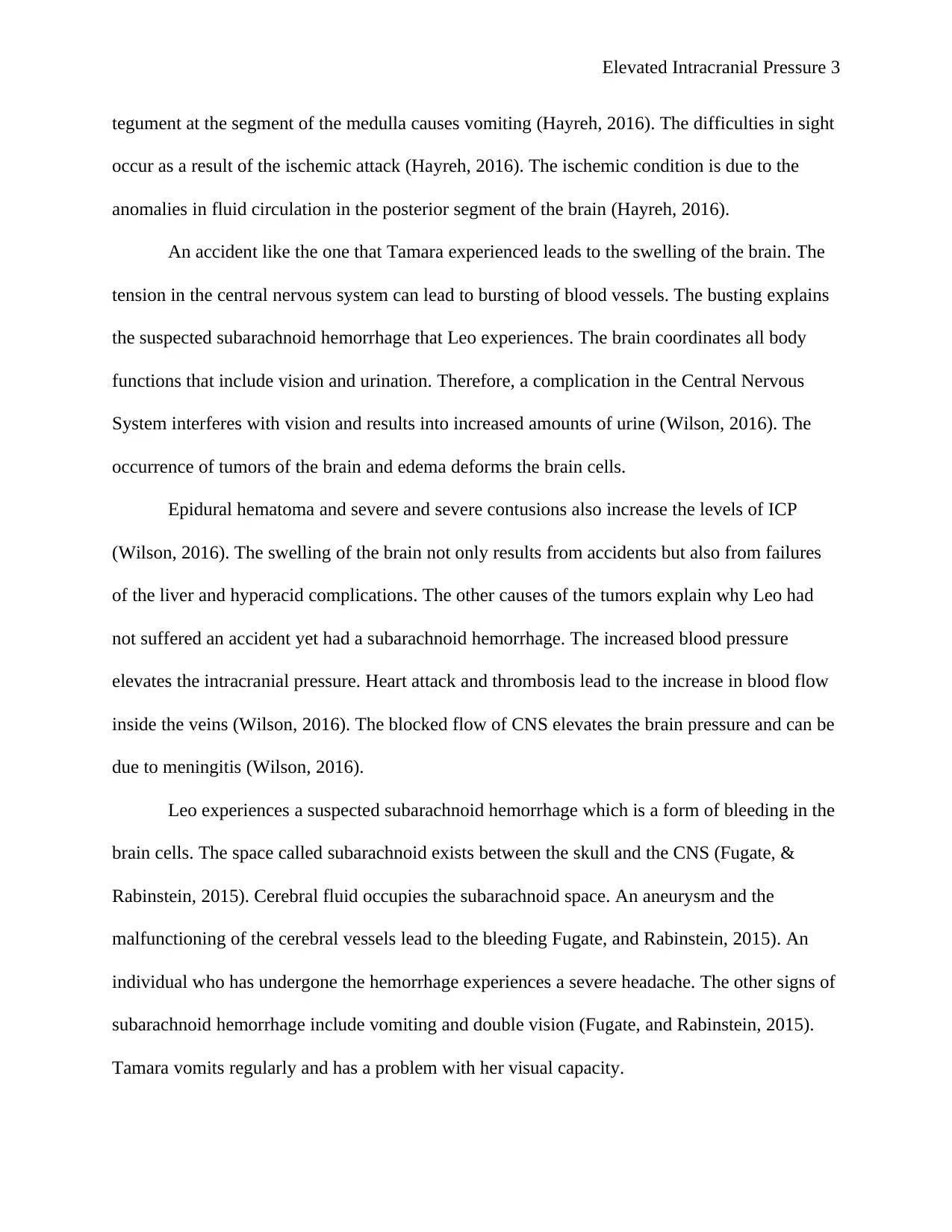
Elevated Intracranial Pressure 3
tegument at the segment of the medulla causes vomiting (Hayreh, 2016). The difficulties in sight
occur as a result of the ischemic attack (Hayreh, 2016). The ischemic condition is due to the
anomalies in fluid circulation in the posterior segment of the brain (Hayreh, 2016).
An accident like the one that Tamara experienced leads to the swelling of the brain. The
tension in the central nervous system can lead to bursting of blood vessels. The busting explains
the suspected subarachnoid hemorrhage that Leo experiences. The brain coordinates all body
functions that include vision and urination. Therefore, a complication in the Central Nervous
System interferes with vision and results into increased amounts of urine (Wilson, 2016). The
occurrence of tumors of the brain and edema deforms the brain cells.
Epidural hematoma and severe and severe contusions also increase the levels of ICP
(Wilson, 2016). The swelling of the brain not only results from accidents but also from failures
of the liver and hyperacid complications. The other causes of the tumors explain why Leo had
not suffered an accident yet had a subarachnoid hemorrhage. The increased blood pressure
elevates the intracranial pressure. Heart attack and thrombosis lead to the increase in blood flow
inside the veins (Wilson, 2016). The blocked flow of CNS elevates the brain pressure and can be
due to meningitis (Wilson, 2016).
Leo experiences a suspected subarachnoid hemorrhage which is a form of bleeding in the
brain cells. The space called subarachnoid exists between the skull and the CNS (Fugate, &
Rabinstein, 2015). Cerebral fluid occupies the subarachnoid space. An aneurysm and the
malfunctioning of the cerebral vessels lead to the bleeding Fugate, and Rabinstein, 2015). An
individual who has undergone the hemorrhage experiences a severe headache. The other signs of
subarachnoid hemorrhage include vomiting and double vision (Fugate, and Rabinstein, 2015).
Tamara vomits regularly and has a problem with her visual capacity.
tegument at the segment of the medulla causes vomiting (Hayreh, 2016). The difficulties in sight
occur as a result of the ischemic attack (Hayreh, 2016). The ischemic condition is due to the
anomalies in fluid circulation in the posterior segment of the brain (Hayreh, 2016).
An accident like the one that Tamara experienced leads to the swelling of the brain. The
tension in the central nervous system can lead to bursting of blood vessels. The busting explains
the suspected subarachnoid hemorrhage that Leo experiences. The brain coordinates all body
functions that include vision and urination. Therefore, a complication in the Central Nervous
System interferes with vision and results into increased amounts of urine (Wilson, 2016). The
occurrence of tumors of the brain and edema deforms the brain cells.
Epidural hematoma and severe and severe contusions also increase the levels of ICP
(Wilson, 2016). The swelling of the brain not only results from accidents but also from failures
of the liver and hyperacid complications. The other causes of the tumors explain why Leo had
not suffered an accident yet had a subarachnoid hemorrhage. The increased blood pressure
elevates the intracranial pressure. Heart attack and thrombosis lead to the increase in blood flow
inside the veins (Wilson, 2016). The blocked flow of CNS elevates the brain pressure and can be
due to meningitis (Wilson, 2016).
Leo experiences a suspected subarachnoid hemorrhage which is a form of bleeding in the
brain cells. The space called subarachnoid exists between the skull and the CNS (Fugate, &
Rabinstein, 2015). Cerebral fluid occupies the subarachnoid space. An aneurysm and the
malfunctioning of the cerebral vessels lead to the bleeding Fugate, and Rabinstein, 2015). An
individual who has undergone the hemorrhage experiences a severe headache. The other signs of
subarachnoid hemorrhage include vomiting and double vision (Fugate, and Rabinstein, 2015).
Tamara vomits regularly and has a problem with her visual capacity.
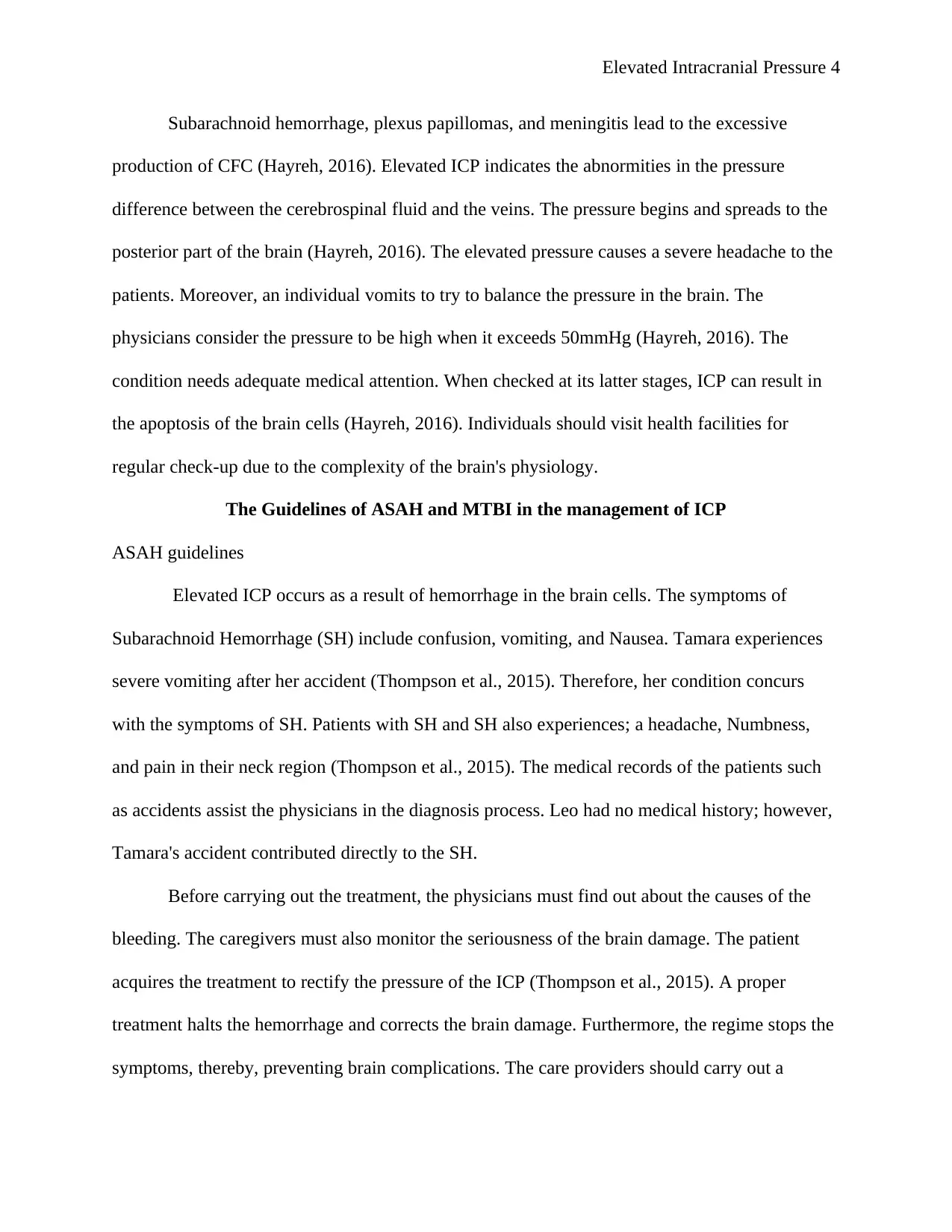
Elevated Intracranial Pressure 4
Subarachnoid hemorrhage, plexus papillomas, and meningitis lead to the excessive
production of CFC (Hayreh, 2016). Elevated ICP indicates the abnormities in the pressure
difference between the cerebrospinal fluid and the veins. The pressure begins and spreads to the
posterior part of the brain (Hayreh, 2016). The elevated pressure causes a severe headache to the
patients. Moreover, an individual vomits to try to balance the pressure in the brain. The
physicians consider the pressure to be high when it exceeds 50mmHg (Hayreh, 2016). The
condition needs adequate medical attention. When checked at its latter stages, ICP can result in
the apoptosis of the brain cells (Hayreh, 2016). Individuals should visit health facilities for
regular check-up due to the complexity of the brain's physiology.
The Guidelines of ASAH and MTBI in the management of ICP
ASAH guidelines
Elevated ICP occurs as a result of hemorrhage in the brain cells. The symptoms of
Subarachnoid Hemorrhage (SH) include confusion, vomiting, and Nausea. Tamara experiences
severe vomiting after her accident (Thompson et al., 2015). Therefore, her condition concurs
with the symptoms of SH. Patients with SH and SH also experiences; a headache, Numbness,
and pain in their neck region (Thompson et al., 2015). The medical records of the patients such
as accidents assist the physicians in the diagnosis process. Leo had no medical history; however,
Tamara's accident contributed directly to the SH.
Before carrying out the treatment, the physicians must find out about the causes of the
bleeding. The caregivers must also monitor the seriousness of the brain damage. The patient
acquires the treatment to rectify the pressure of the ICP (Thompson et al., 2015). A proper
treatment halts the hemorrhage and corrects the brain damage. Furthermore, the regime stops the
symptoms, thereby, preventing brain complications. The care providers should carry out a
Subarachnoid hemorrhage, plexus papillomas, and meningitis lead to the excessive
production of CFC (Hayreh, 2016). Elevated ICP indicates the abnormities in the pressure
difference between the cerebrospinal fluid and the veins. The pressure begins and spreads to the
posterior part of the brain (Hayreh, 2016). The elevated pressure causes a severe headache to the
patients. Moreover, an individual vomits to try to balance the pressure in the brain. The
physicians consider the pressure to be high when it exceeds 50mmHg (Hayreh, 2016). The
condition needs adequate medical attention. When checked at its latter stages, ICP can result in
the apoptosis of the brain cells (Hayreh, 2016). Individuals should visit health facilities for
regular check-up due to the complexity of the brain's physiology.
The Guidelines of ASAH and MTBI in the management of ICP
ASAH guidelines
Elevated ICP occurs as a result of hemorrhage in the brain cells. The symptoms of
Subarachnoid Hemorrhage (SH) include confusion, vomiting, and Nausea. Tamara experiences
severe vomiting after her accident (Thompson et al., 2015). Therefore, her condition concurs
with the symptoms of SH. Patients with SH and SH also experiences; a headache, Numbness,
and pain in their neck region (Thompson et al., 2015). The medical records of the patients such
as accidents assist the physicians in the diagnosis process. Leo had no medical history; however,
Tamara's accident contributed directly to the SH.
Before carrying out the treatment, the physicians must find out about the causes of the
bleeding. The caregivers must also monitor the seriousness of the brain damage. The patient
acquires the treatment to rectify the pressure of the ICP (Thompson et al., 2015). A proper
treatment halts the hemorrhage and corrects the brain damage. Furthermore, the regime stops the
symptoms, thereby, preventing brain complications. The care providers should carry out a
Secure Best Marks with AI Grader
Need help grading? Try our AI Grader for instant feedback on your assignments.

Elevated Intracranial Pressure 5
thorough treatment process to permanently cure the disease. Patients who have suffered for an
extended period require an extended rehabilitation and recovery process.
Individuals who have hypertension and complications of the kidney are at the highest
risks of ICP (Thompson et al., 2015). The anomalies of the kidney explain the increased urine
output that Leo experienced. Individuals who smoke cigarette also have high chances of getting
ICP (Pasarikovski et al., 2017). Idiopathic complications and head injury lead to the onset of SH
and consequently ICP. The damage to Tamara made the physicians suspect that she was
suffering from the two conditions. Moreover, aneurysm and arteriovascular abnormities also lead
to the onset of the brain hemorrhage.
Infections that have the same symptoms as those of ICP include a Migraine, Meningitis,
Stroke, and Encephalitis (Magni et al., 2015). Diagnosis involves the checking of a patient's
records and physical tests. Moreover, neurological tests are also essential before the onset of
treatment. CT scan should indicate the bleeding area of the brain if an individual if a victim of
ICP. MRA and MRI also test for the bleeding parts (Carney et al., 2017). Treatment includes a
suggestion of bed rest for the patient. Moreover, the physician and the family members should
monitor the symptoms of the disease. Ventilation and incubation also balance the pressure in the
brain (Carney et al., 2017).
Surgery and medication are also regiments to correct ICP. The operation is necessary
when trauma and aneurysm are the causes of the hemorrhage (Carney et al., 2017). The process
halts the bleeding and heals the resulting wound (Carney et al., 2017). Medications prevent a
headache and seizures (Carney et al., 2017). The prescribed drugs also regulate the flow of blood
in the vessels and improve relaxation of the venous muscles (Carney et al., 2017). The clinicians
should also recommend the recovery steps for the patient.
thorough treatment process to permanently cure the disease. Patients who have suffered for an
extended period require an extended rehabilitation and recovery process.
Individuals who have hypertension and complications of the kidney are at the highest
risks of ICP (Thompson et al., 2015). The anomalies of the kidney explain the increased urine
output that Leo experienced. Individuals who smoke cigarette also have high chances of getting
ICP (Pasarikovski et al., 2017). Idiopathic complications and head injury lead to the onset of SH
and consequently ICP. The damage to Tamara made the physicians suspect that she was
suffering from the two conditions. Moreover, aneurysm and arteriovascular abnormities also lead
to the onset of the brain hemorrhage.
Infections that have the same symptoms as those of ICP include a Migraine, Meningitis,
Stroke, and Encephalitis (Magni et al., 2015). Diagnosis involves the checking of a patient's
records and physical tests. Moreover, neurological tests are also essential before the onset of
treatment. CT scan should indicate the bleeding area of the brain if an individual if a victim of
ICP. MRA and MRI also test for the bleeding parts (Carney et al., 2017). Treatment includes a
suggestion of bed rest for the patient. Moreover, the physician and the family members should
monitor the symptoms of the disease. Ventilation and incubation also balance the pressure in the
brain (Carney et al., 2017).
Surgery and medication are also regiments to correct ICP. The operation is necessary
when trauma and aneurysm are the causes of the hemorrhage (Carney et al., 2017). The process
halts the bleeding and heals the resulting wound (Carney et al., 2017). Medications prevent a
headache and seizures (Carney et al., 2017). The prescribed drugs also regulate the flow of blood
in the vessels and improve relaxation of the venous muscles (Carney et al., 2017). The clinicians
should also recommend the recovery steps for the patient.
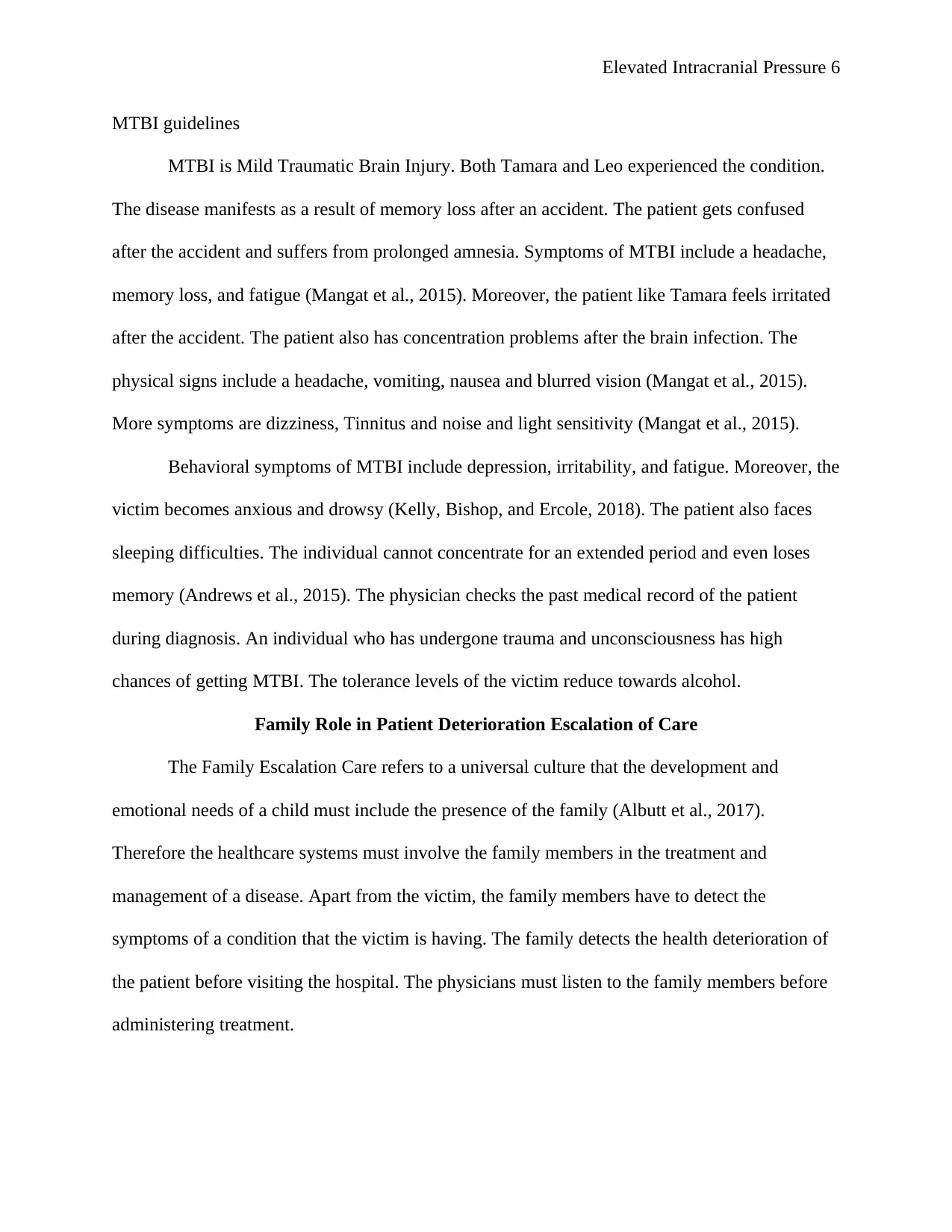
Elevated Intracranial Pressure 6
MTBI guidelines
MTBI is Mild Traumatic Brain Injury. Both Tamara and Leo experienced the condition.
The disease manifests as a result of memory loss after an accident. The patient gets confused
after the accident and suffers from prolonged amnesia. Symptoms of MTBI include a headache,
memory loss, and fatigue (Mangat et al., 2015). Moreover, the patient like Tamara feels irritated
after the accident. The patient also has concentration problems after the brain infection. The
physical signs include a headache, vomiting, nausea and blurred vision (Mangat et al., 2015).
More symptoms are dizziness, Tinnitus and noise and light sensitivity (Mangat et al., 2015).
Behavioral symptoms of MTBI include depression, irritability, and fatigue. Moreover, the
victim becomes anxious and drowsy (Kelly, Bishop, and Ercole, 2018). The patient also faces
sleeping difficulties. The individual cannot concentrate for an extended period and even loses
memory (Andrews et al., 2015). The physician checks the past medical record of the patient
during diagnosis. An individual who has undergone trauma and unconsciousness has high
chances of getting MTBI. The tolerance levels of the victim reduce towards alcohol.
Family Role in Patient Deterioration Escalation of Care
The Family Escalation Care refers to a universal culture that the development and
emotional needs of a child must include the presence of the family (Albutt et al., 2017).
Therefore the healthcare systems must involve the family members in the treatment and
management of a disease. Apart from the victim, the family members have to detect the
symptoms of a condition that the victim is having. The family detects the health deterioration of
the patient before visiting the hospital. The physicians must listen to the family members before
administering treatment.
MTBI guidelines
MTBI is Mild Traumatic Brain Injury. Both Tamara and Leo experienced the condition.
The disease manifests as a result of memory loss after an accident. The patient gets confused
after the accident and suffers from prolonged amnesia. Symptoms of MTBI include a headache,
memory loss, and fatigue (Mangat et al., 2015). Moreover, the patient like Tamara feels irritated
after the accident. The patient also has concentration problems after the brain infection. The
physical signs include a headache, vomiting, nausea and blurred vision (Mangat et al., 2015).
More symptoms are dizziness, Tinnitus and noise and light sensitivity (Mangat et al., 2015).
Behavioral symptoms of MTBI include depression, irritability, and fatigue. Moreover, the
victim becomes anxious and drowsy (Kelly, Bishop, and Ercole, 2018). The patient also faces
sleeping difficulties. The individual cannot concentrate for an extended period and even loses
memory (Andrews et al., 2015). The physician checks the past medical record of the patient
during diagnosis. An individual who has undergone trauma and unconsciousness has high
chances of getting MTBI. The tolerance levels of the victim reduce towards alcohol.
Family Role in Patient Deterioration Escalation of Care
The Family Escalation Care refers to a universal culture that the development and
emotional needs of a child must include the presence of the family (Albutt et al., 2017).
Therefore the healthcare systems must involve the family members in the treatment and
management of a disease. Apart from the victim, the family members have to detect the
symptoms of a condition that the victim is having. The family detects the health deterioration of
the patient before visiting the hospital. The physicians must listen to the family members before
administering treatment.
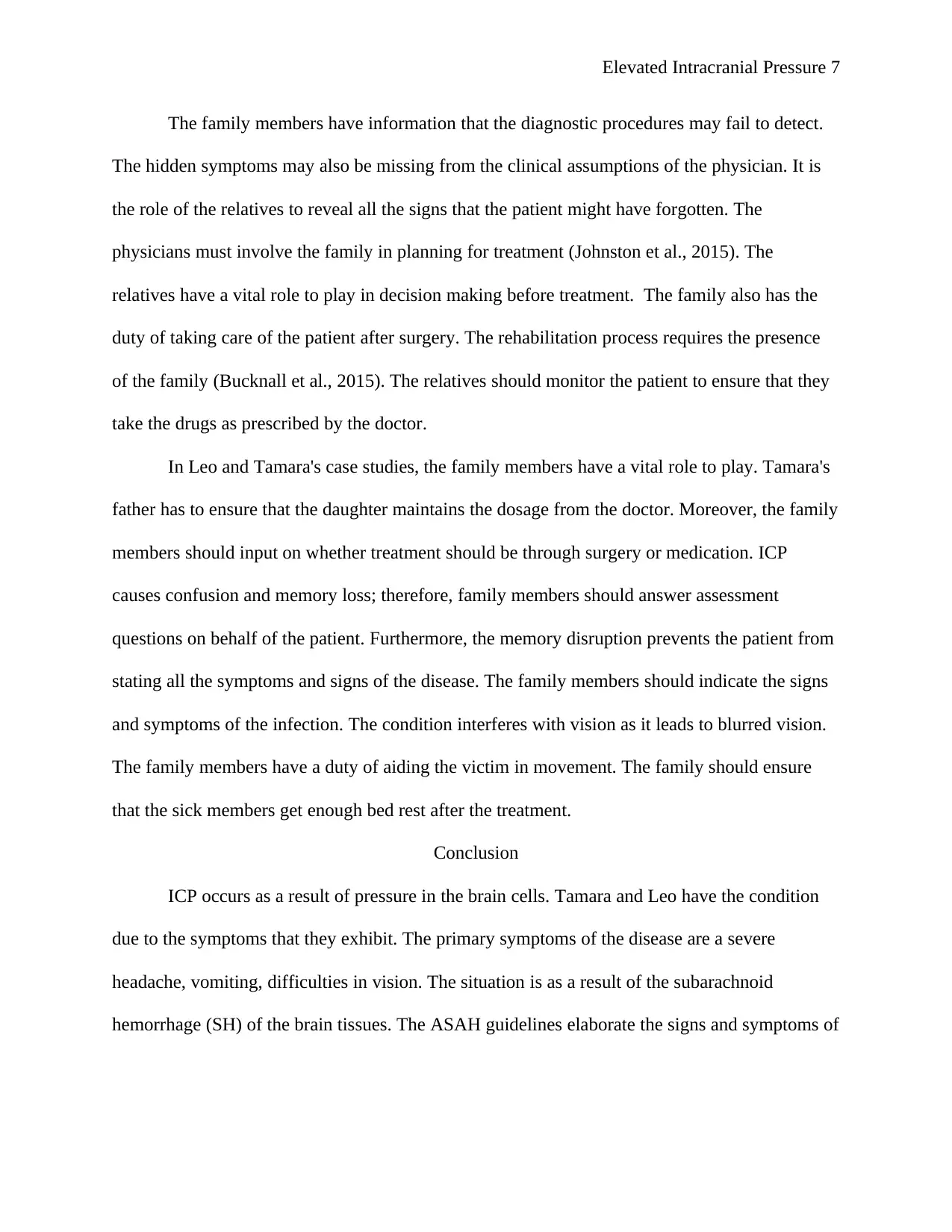
Elevated Intracranial Pressure 7
The family members have information that the diagnostic procedures may fail to detect.
The hidden symptoms may also be missing from the clinical assumptions of the physician. It is
the role of the relatives to reveal all the signs that the patient might have forgotten. The
physicians must involve the family in planning for treatment (Johnston et al., 2015). The
relatives have a vital role to play in decision making before treatment. The family also has the
duty of taking care of the patient after surgery. The rehabilitation process requires the presence
of the family (Bucknall et al., 2015). The relatives should monitor the patient to ensure that they
take the drugs as prescribed by the doctor.
In Leo and Tamara's case studies, the family members have a vital role to play. Tamara's
father has to ensure that the daughter maintains the dosage from the doctor. Moreover, the family
members should input on whether treatment should be through surgery or medication. ICP
causes confusion and memory loss; therefore, family members should answer assessment
questions on behalf of the patient. Furthermore, the memory disruption prevents the patient from
stating all the symptoms and signs of the disease. The family members should indicate the signs
and symptoms of the infection. The condition interferes with vision as it leads to blurred vision.
The family members have a duty of aiding the victim in movement. The family should ensure
that the sick members get enough bed rest after the treatment.
Conclusion
ICP occurs as a result of pressure in the brain cells. Tamara and Leo have the condition
due to the symptoms that they exhibit. The primary symptoms of the disease are a severe
headache, vomiting, difficulties in vision. The situation is as a result of the subarachnoid
hemorrhage (SH) of the brain tissues. The ASAH guidelines elaborate the signs and symptoms of
The family members have information that the diagnostic procedures may fail to detect.
The hidden symptoms may also be missing from the clinical assumptions of the physician. It is
the role of the relatives to reveal all the signs that the patient might have forgotten. The
physicians must involve the family in planning for treatment (Johnston et al., 2015). The
relatives have a vital role to play in decision making before treatment. The family also has the
duty of taking care of the patient after surgery. The rehabilitation process requires the presence
of the family (Bucknall et al., 2015). The relatives should monitor the patient to ensure that they
take the drugs as prescribed by the doctor.
In Leo and Tamara's case studies, the family members have a vital role to play. Tamara's
father has to ensure that the daughter maintains the dosage from the doctor. Moreover, the family
members should input on whether treatment should be through surgery or medication. ICP
causes confusion and memory loss; therefore, family members should answer assessment
questions on behalf of the patient. Furthermore, the memory disruption prevents the patient from
stating all the symptoms and signs of the disease. The family members should indicate the signs
and symptoms of the infection. The condition interferes with vision as it leads to blurred vision.
The family members have a duty of aiding the victim in movement. The family should ensure
that the sick members get enough bed rest after the treatment.
Conclusion
ICP occurs as a result of pressure in the brain cells. Tamara and Leo have the condition
due to the symptoms that they exhibit. The primary symptoms of the disease are a severe
headache, vomiting, difficulties in vision. The situation is as a result of the subarachnoid
hemorrhage (SH) of the brain tissues. The ASAH guidelines elaborate the signs and symptoms of
Paraphrase This Document
Need a fresh take? Get an instant paraphrase of this document with our AI Paraphraser
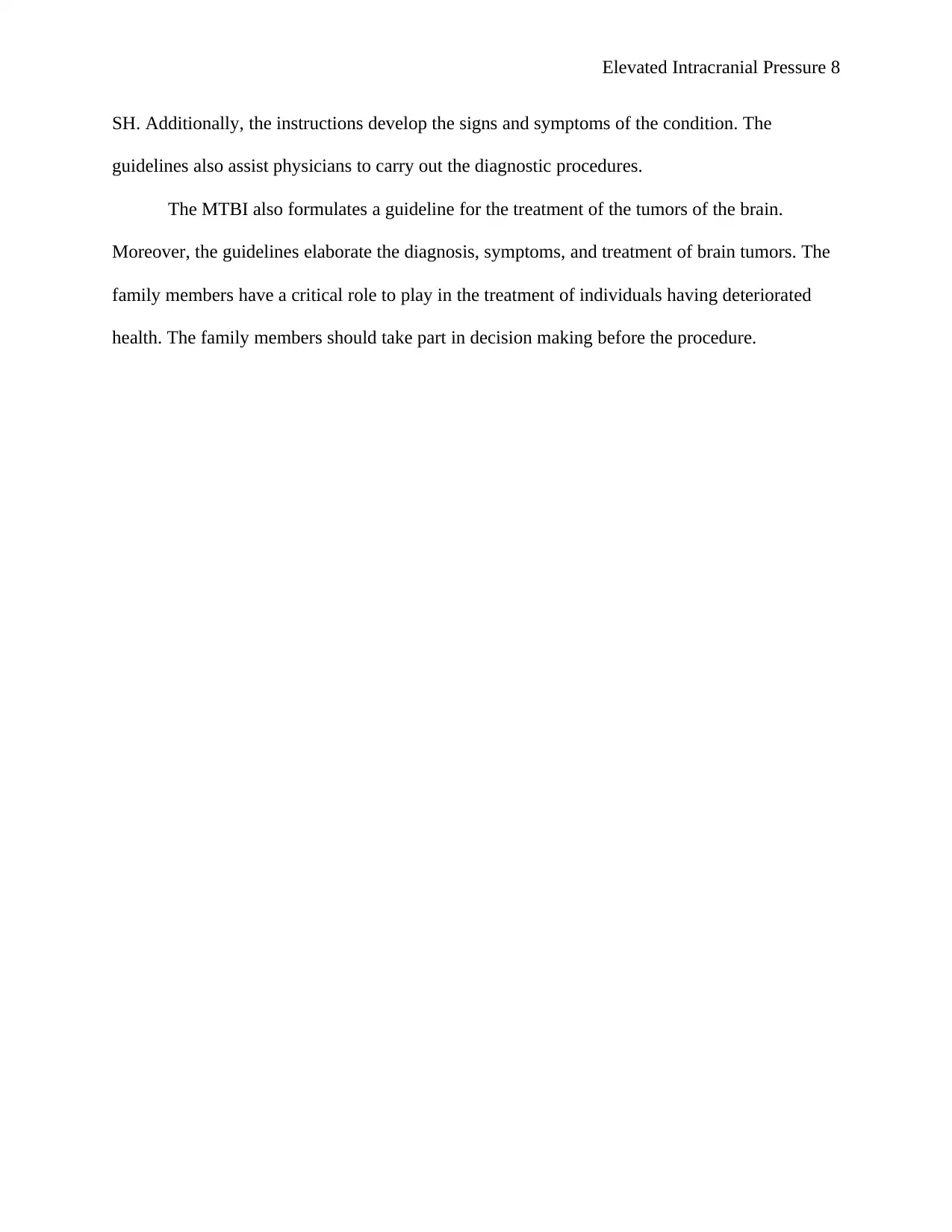
Elevated Intracranial Pressure 8
SH. Additionally, the instructions develop the signs and symptoms of the condition. The
guidelines also assist physicians to carry out the diagnostic procedures.
The MTBI also formulates a guideline for the treatment of the tumors of the brain.
Moreover, the guidelines elaborate the diagnosis, symptoms, and treatment of brain tumors. The
family members have a critical role to play in the treatment of individuals having deteriorated
health. The family members should take part in decision making before the procedure.
SH. Additionally, the instructions develop the signs and symptoms of the condition. The
guidelines also assist physicians to carry out the diagnostic procedures.
The MTBI also formulates a guideline for the treatment of the tumors of the brain.
Moreover, the guidelines elaborate the diagnosis, symptoms, and treatment of brain tumors. The
family members have a critical role to play in the treatment of individuals having deteriorated
health. The family members should take part in decision making before the procedure.
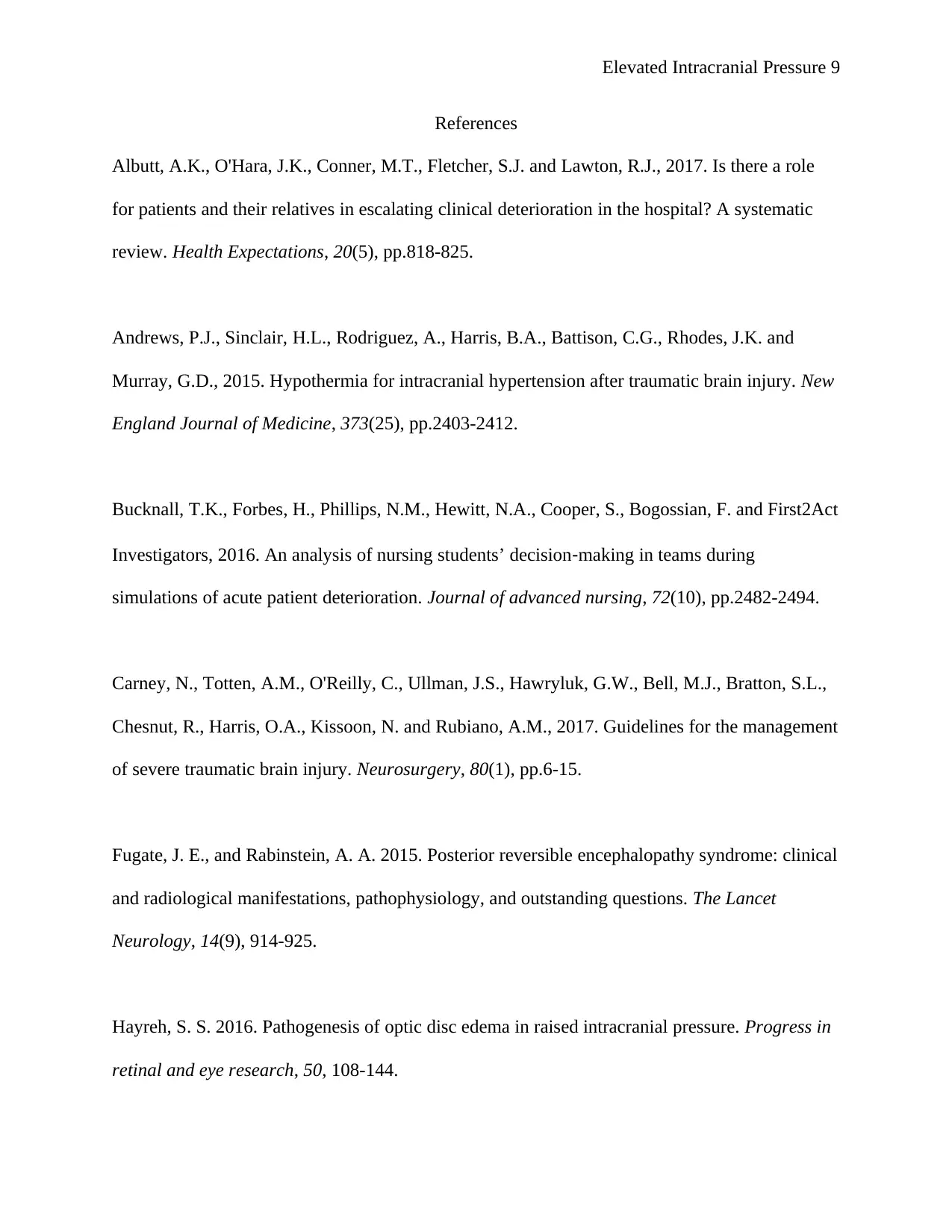
Elevated Intracranial Pressure 9
References
Albutt, A.K., O'Hara, J.K., Conner, M.T., Fletcher, S.J. and Lawton, R.J., 2017. Is there a role
for patients and their relatives in escalating clinical deterioration in the hospital? A systematic
review. Health Expectations, 20(5), pp.818-825.
Andrews, P.J., Sinclair, H.L., Rodriguez, A., Harris, B.A., Battison, C.G., Rhodes, J.K. and
Murray, G.D., 2015. Hypothermia for intracranial hypertension after traumatic brain injury. New
England Journal of Medicine, 373(25), pp.2403-2412.
Bucknall, T.K., Forbes, H., Phillips, N.M., Hewitt, N.A., Cooper, S., Bogossian, F. and First2Act
Investigators, 2016. An analysis of nursing students’ decision‐making in teams during
simulations of acute patient deterioration. Journal of advanced nursing, 72(10), pp.2482-2494.
Carney, N., Totten, A.M., O'Reilly, C., Ullman, J.S., Hawryluk, G.W., Bell, M.J., Bratton, S.L.,
Chesnut, R., Harris, O.A., Kissoon, N. and Rubiano, A.M., 2017. Guidelines for the management
of severe traumatic brain injury. Neurosurgery, 80(1), pp.6-15.
Fugate, J. E., and Rabinstein, A. A. 2015. Posterior reversible encephalopathy syndrome: clinical
and radiological manifestations, pathophysiology, and outstanding questions. The Lancet
Neurology, 14(9), 914-925.
Hayreh, S. S. 2016. Pathogenesis of optic disc edema in raised intracranial pressure. Progress in
retinal and eye research, 50, 108-144.
References
Albutt, A.K., O'Hara, J.K., Conner, M.T., Fletcher, S.J. and Lawton, R.J., 2017. Is there a role
for patients and their relatives in escalating clinical deterioration in the hospital? A systematic
review. Health Expectations, 20(5), pp.818-825.
Andrews, P.J., Sinclair, H.L., Rodriguez, A., Harris, B.A., Battison, C.G., Rhodes, J.K. and
Murray, G.D., 2015. Hypothermia for intracranial hypertension after traumatic brain injury. New
England Journal of Medicine, 373(25), pp.2403-2412.
Bucknall, T.K., Forbes, H., Phillips, N.M., Hewitt, N.A., Cooper, S., Bogossian, F. and First2Act
Investigators, 2016. An analysis of nursing students’ decision‐making in teams during
simulations of acute patient deterioration. Journal of advanced nursing, 72(10), pp.2482-2494.
Carney, N., Totten, A.M., O'Reilly, C., Ullman, J.S., Hawryluk, G.W., Bell, M.J., Bratton, S.L.,
Chesnut, R., Harris, O.A., Kissoon, N. and Rubiano, A.M., 2017. Guidelines for the management
of severe traumatic brain injury. Neurosurgery, 80(1), pp.6-15.
Fugate, J. E., and Rabinstein, A. A. 2015. Posterior reversible encephalopathy syndrome: clinical
and radiological manifestations, pathophysiology, and outstanding questions. The Lancet
Neurology, 14(9), 914-925.
Hayreh, S. S. 2016. Pathogenesis of optic disc edema in raised intracranial pressure. Progress in
retinal and eye research, 50, 108-144.
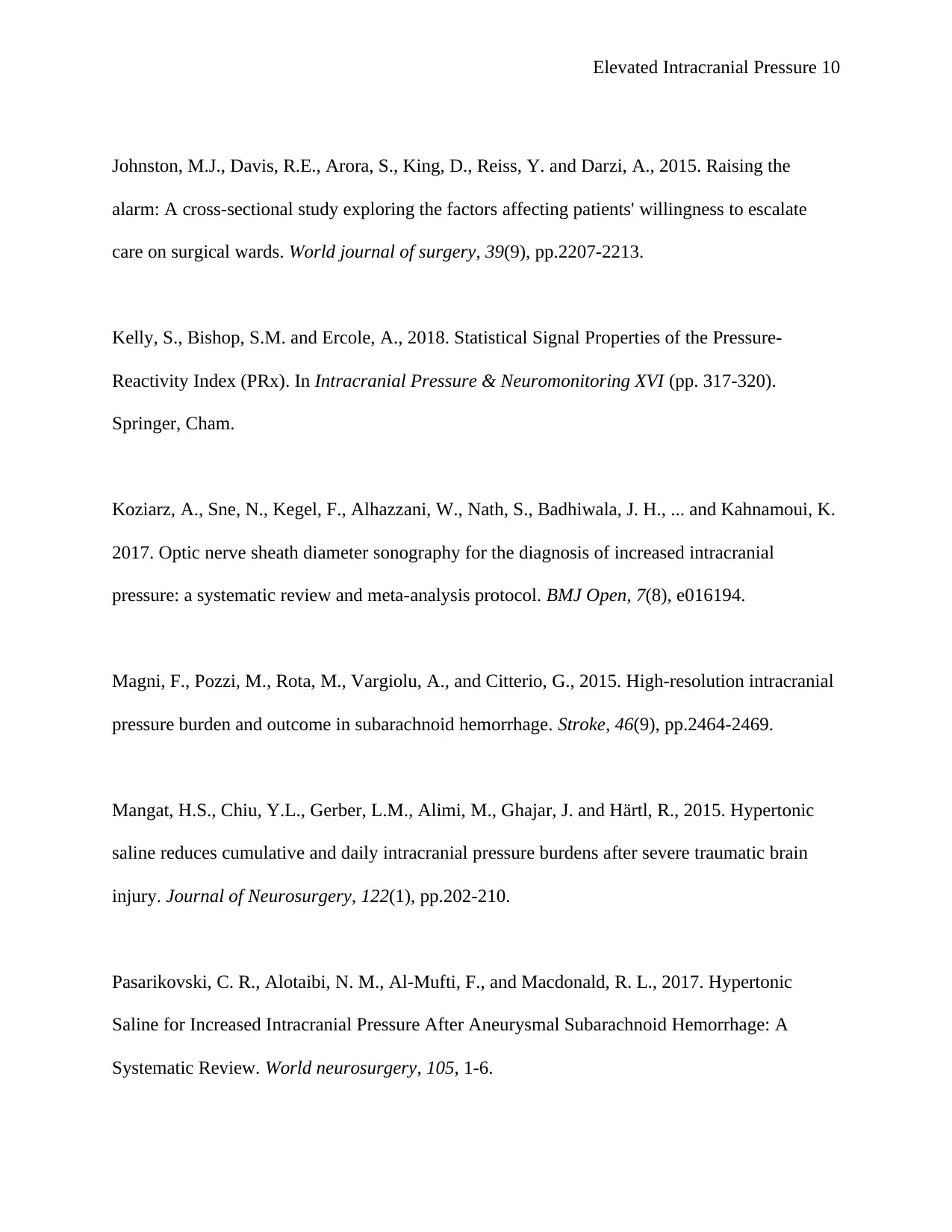
Elevated Intracranial Pressure 10
Johnston, M.J., Davis, R.E., Arora, S., King, D., Reiss, Y. and Darzi, A., 2015. Raising the
alarm: A cross-sectional study exploring the factors affecting patients' willingness to escalate
care on surgical wards. World journal of surgery, 39(9), pp.2207-2213.
Kelly, S., Bishop, S.M. and Ercole, A., 2018. Statistical Signal Properties of the Pressure-
Reactivity Index (PRx). In Intracranial Pressure & Neuromonitoring XVI (pp. 317-320).
Springer, Cham.
Koziarz, A., Sne, N., Kegel, F., Alhazzani, W., Nath, S., Badhiwala, J. H., ... and Kahnamoui, K.
2017. Optic nerve sheath diameter sonography for the diagnosis of increased intracranial
pressure: a systematic review and meta-analysis protocol. BMJ Open, 7(8), e016194.
Magni, F., Pozzi, M., Rota, M., Vargiolu, A., and Citterio, G., 2015. High-resolution intracranial
pressure burden and outcome in subarachnoid hemorrhage. Stroke, 46(9), pp.2464-2469.
Mangat, H.S., Chiu, Y.L., Gerber, L.M., Alimi, M., Ghajar, J. and Härtl, R., 2015. Hypertonic
saline reduces cumulative and daily intracranial pressure burdens after severe traumatic brain
injury. Journal of Neurosurgery, 122(1), pp.202-210.
Pasarikovski, C. R., Alotaibi, N. M., Al-Mufti, F., and Macdonald, R. L., 2017. Hypertonic
Saline for Increased Intracranial Pressure After Aneurysmal Subarachnoid Hemorrhage: A
Systematic Review. World neurosurgery, 105, 1-6.
Johnston, M.J., Davis, R.E., Arora, S., King, D., Reiss, Y. and Darzi, A., 2015. Raising the
alarm: A cross-sectional study exploring the factors affecting patients' willingness to escalate
care on surgical wards. World journal of surgery, 39(9), pp.2207-2213.
Kelly, S., Bishop, S.M. and Ercole, A., 2018. Statistical Signal Properties of the Pressure-
Reactivity Index (PRx). In Intracranial Pressure & Neuromonitoring XVI (pp. 317-320).
Springer, Cham.
Koziarz, A., Sne, N., Kegel, F., Alhazzani, W., Nath, S., Badhiwala, J. H., ... and Kahnamoui, K.
2017. Optic nerve sheath diameter sonography for the diagnosis of increased intracranial
pressure: a systematic review and meta-analysis protocol. BMJ Open, 7(8), e016194.
Magni, F., Pozzi, M., Rota, M., Vargiolu, A., and Citterio, G., 2015. High-resolution intracranial
pressure burden and outcome in subarachnoid hemorrhage. Stroke, 46(9), pp.2464-2469.
Mangat, H.S., Chiu, Y.L., Gerber, L.M., Alimi, M., Ghajar, J. and Härtl, R., 2015. Hypertonic
saline reduces cumulative and daily intracranial pressure burdens after severe traumatic brain
injury. Journal of Neurosurgery, 122(1), pp.202-210.
Pasarikovski, C. R., Alotaibi, N. M., Al-Mufti, F., and Macdonald, R. L., 2017. Hypertonic
Saline for Increased Intracranial Pressure After Aneurysmal Subarachnoid Hemorrhage: A
Systematic Review. World neurosurgery, 105, 1-6.
Secure Best Marks with AI Grader
Need help grading? Try our AI Grader for instant feedback on your assignments.
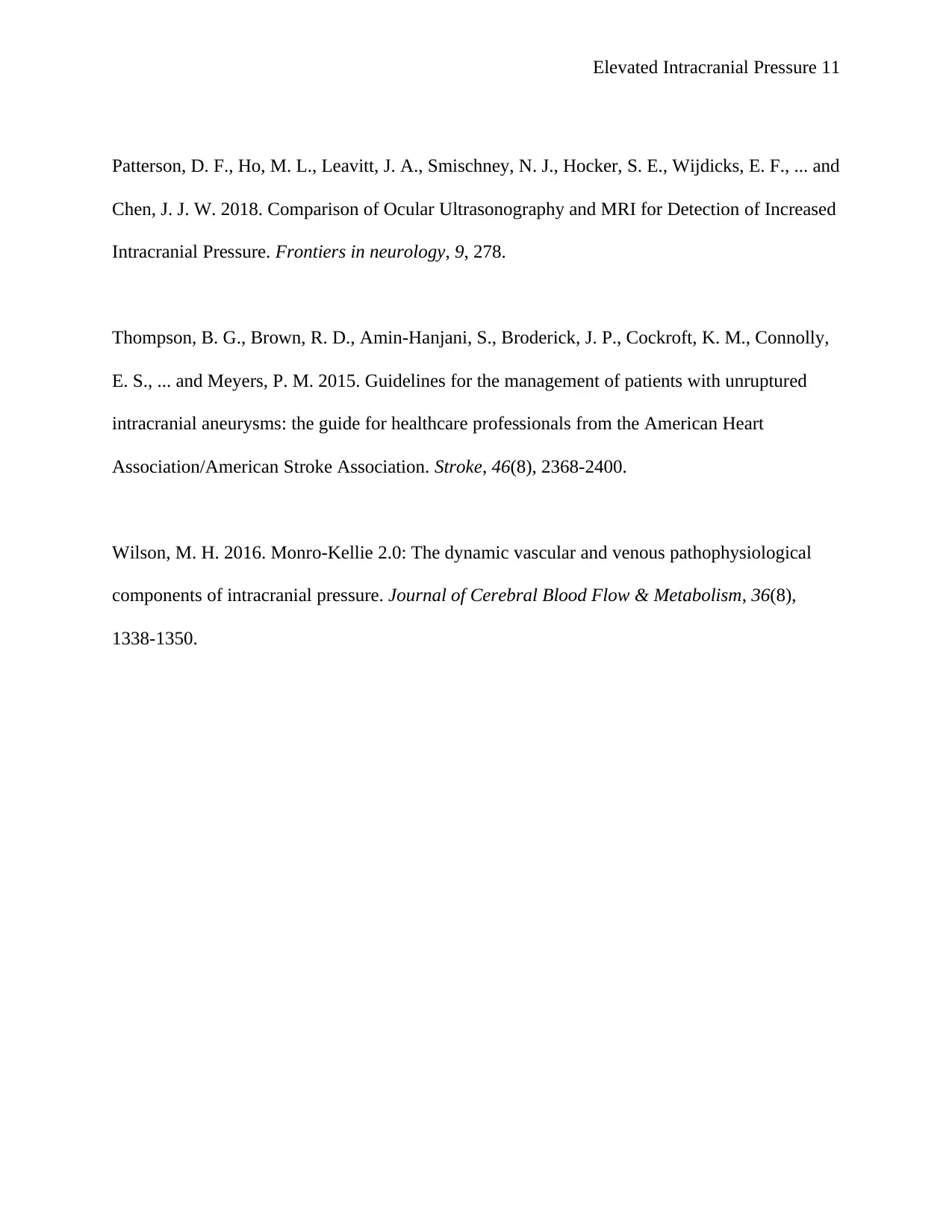
Elevated Intracranial Pressure 11
Patterson, D. F., Ho, M. L., Leavitt, J. A., Smischney, N. J., Hocker, S. E., Wijdicks, E. F., ... and
Chen, J. J. W. 2018. Comparison of Ocular Ultrasonography and MRI for Detection of Increased
Intracranial Pressure. Frontiers in neurology, 9, 278.
Thompson, B. G., Brown, R. D., Amin-Hanjani, S., Broderick, J. P., Cockroft, K. M., Connolly,
E. S., ... and Meyers, P. M. 2015. Guidelines for the management of patients with unruptured
intracranial aneurysms: the guide for healthcare professionals from the American Heart
Association/American Stroke Association. Stroke, 46(8), 2368-2400.
Wilson, M. H. 2016. Monro-Kellie 2.0: The dynamic vascular and venous pathophysiological
components of intracranial pressure. Journal of Cerebral Blood Flow & Metabolism, 36(8),
1338-1350.
Patterson, D. F., Ho, M. L., Leavitt, J. A., Smischney, N. J., Hocker, S. E., Wijdicks, E. F., ... and
Chen, J. J. W. 2018. Comparison of Ocular Ultrasonography and MRI for Detection of Increased
Intracranial Pressure. Frontiers in neurology, 9, 278.
Thompson, B. G., Brown, R. D., Amin-Hanjani, S., Broderick, J. P., Cockroft, K. M., Connolly,
E. S., ... and Meyers, P. M. 2015. Guidelines for the management of patients with unruptured
intracranial aneurysms: the guide for healthcare professionals from the American Heart
Association/American Stroke Association. Stroke, 46(8), 2368-2400.
Wilson, M. H. 2016. Monro-Kellie 2.0: The dynamic vascular and venous pathophysiological
components of intracranial pressure. Journal of Cerebral Blood Flow & Metabolism, 36(8),
1338-1350.
1 out of 11
Related Documents
Your All-in-One AI-Powered Toolkit for Academic Success.
+13062052269
info@desklib.com
Available 24*7 on WhatsApp / Email
![[object Object]](/_next/static/media/star-bottom.7253800d.svg)
Unlock your academic potential
© 2024 | Zucol Services PVT LTD | All rights reserved.





